Ending the small clear and bright holiday, we are about to usher in the May Day holiday. From a time point of view, the annual New Year's Day, Spring Festival, May 1 and 11 holidays are often the peak season for home appliance sales. Many consumers choose to shop for a three-day holiday or a seven-day holiday. Recently, Ovid Cloud Network (AVC) announced a set of television forecast data during the May 1st period of 2016. The data includes the sales of television in 2016, and what TV is most favored by consumers during the 51st period. From these data, we can also learn about some future TV market trends. Not much to say, this week's "Home Appliances Big Data" 36, we will look at the 2016 opening of the domestic television market and 51 during the big data.

â– In 2016, TV sales will start to drop slightly
Let's take a look at the trend of the television market after the group opened in 2016. According to big data, in January 2016, domestic TV sales totaled 5.87 million units and sales were 18.6 billion yuan. In February 2016, domestic TV sales totaled 3.14 million units and sales reached 8.9 billion yuan. Compared with the cumulative sales in the January-February period last year, it was down 0.4% year-on-year. The total retail sales decreased by 6.7 percentage points from the same period of last year.
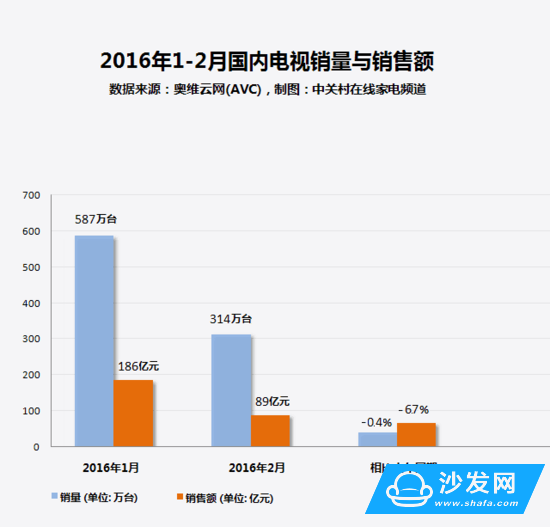
From the above figures, it is not difficult to see that TV sales in January were significantly higher than in February, and the gap between the two reached 2.73 million units. This is because many users who originally planned to purchase in the Spring Festival have purchased before the holiday in advance. Coupled with the impact of the Spring Festival holiday in February, TV sales will be significantly lower than in January.
â– There is a reason behind the steady growth of domestic TV sales
For now, there are various branded TVs in the market, which can be divided into domestic brands, Japanese brands, and Korean brands. So, in the January-February period of 2016, what happened to the brand sales rankings? According to the big data provided by AVC, the brand sales of all brand TVs in the January-February period are as follows:
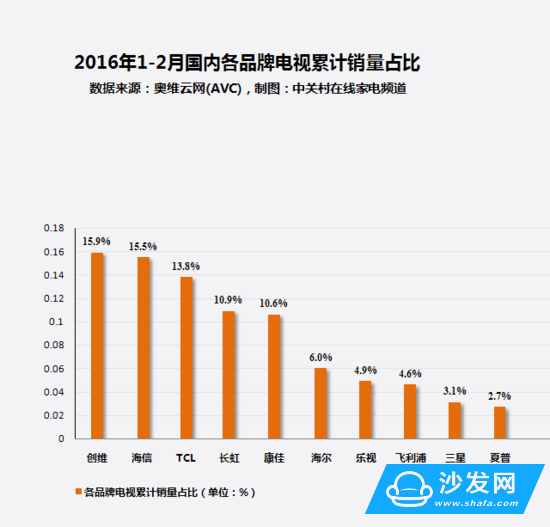
Skyworth's sales accounted for 15.9%, Hisense's sales accounted for 15.5%, TCL's sales accounted for 13.8%, Konka's sales accounted for 10.6%, Changhong's sales accounted for 10.9%, and Haier’s sales accounted for a cumulative proportion. At 6.0%, LeTV’s sales accounted for 4.9% of total sales, Philips’ sales accounted for 4.6%, Samsung’s sales accounted for 3.1%, and Sharp’s sales accounted for 2.7%.
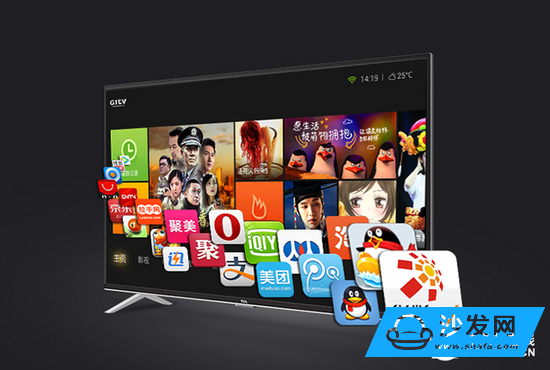
Overall, domestically produced TVs have achieved good sales in January-February this year. Skyworth, Hisense and TCL have occupied the top three sales charts. Of the Internet TV brands, only Leshi appeared, while Japanese brands and Korean brands did not seem to have satisfactory sales. It can be seen that domestically produced TVs have achieved good results in 2016. In fact, in recent years, domestically produced TVs have been greatly improved in technology, and the gap with foreign brands is gradually narrowing. Many rational consumers do not Then blindly follow foreign brands. Domestic TVs have greater advantages in terms of built-in genuine video resources, application stores, etc. After-sales service, also has many years of experience, so it is worth being praised for domestic TV.
Page 2: The entity is still the first choice of 51 million sales forecast 3.02 million units
â– May's TV sales are forecast at 3.02 million units
Then, during the May 1st of this year, will domestic TV sales reach new heights? According to big data, from 2016 to 19 weeks 2016, from April 11 to May 8, 2016, TV sales are expected to total approximately 3.02 million units. Among them, 920,000 units in the 16th week and 910,000 units in the 17th week reached the peak of sales in the 18th week, which was 1.58 million units, and fell to 530,000 units in the 19th week.
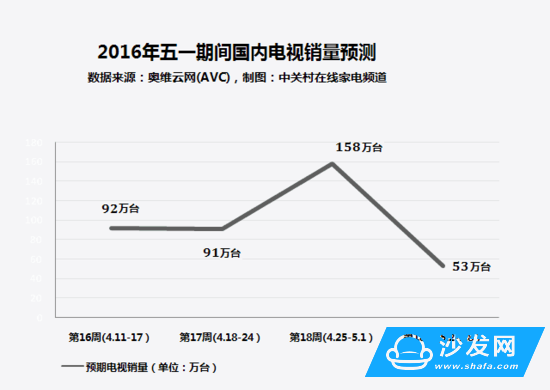
On the whole, it is expected that during the 51st of this year, domestic TV sales will total 3.02 million units, an increase of 2.1 percentage points from the same period of last year. This is because the purchasing power that TV just needs during the May 1st period will be released. For example, some consumers who get married or move to a new home will often purchase in the week of May or earlier, thus boosting the promotion season. Sales during the period.
â– Offline store is still the preferred choice for users
The main channels for TVs purchased now are online and offline. So, will the traditional physical store be surpassed by the online platform? According to big data, it is expected that during the 51st of 2016, the proportion of users who choose to purchase TV through online channels is 21%, which represents an increase of 18% compared to the same period of last year. In contrast, the percentage of users who choose offline channels to purchase TVs is 79%, which is a decrease of 1.4% compared to the same period of last year.
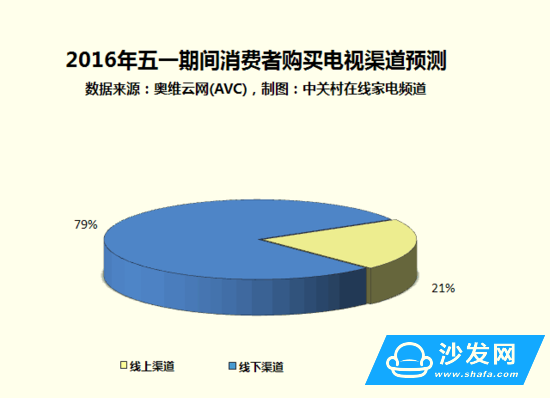

It can be seen that the main channels for consumers to purchase TVs are still offline platforms. Although the share of traditional offline stores has decreased, the proportion still accounts for nearly 80% of the total. In fact, this situation is not surprising. Many consumers have a hope of seeing something when they buy large appliances such as TVs. In particular, nowadays, smart TVs are rich in functions, some functions such as somatosensory games, voice control, and online video platforms. Users are very much willing to go to the stores to experience some purchase decisions, and these are the short boards for online platforms.
Page 3: 55 inches for the big screen overlord's average price has declined
â– 55-inch screen for the overlord
For consumers, the corresponding size products are generally selected according to the purpose of the television, the environment in which it is used, and other factors. Looking at the current TV market, products ranging from 32 inches to 65 inches can be found. Small screen televisions such as 32-inch TVs are more suitable for the dwelling family with a smaller living space, or installed in a bedroom. Large-screen TVs with 50 inches or more are more suitable for users with large living rooms.

According to big data, during the May 1st of 2016, the sales of TVs of various sizes accounted for the following. The sales volume of 32-inch TVs accounted for 18.1%, the sales volume of 39-inch TVs accounted for 4.1%, the sales volume of 40-inch TVs accounted for 7.9%, 42 and 43 inches. Sales accounted for 14.6%, 48-inch sales accounted for 8.1%, 49-inch sales accounted for 8.7%, 50-inch sales accounted for 6.7%, 55-inch sales accounted for 23.1%, and 60-inch sales accounted for 1.6. %, sales of 65 inches accounted for 4.2%.

From this set of data, it can be seen that during the Golden Week, the most popular TVs were 55-inch, 32-inch, and 42- and 43-inch. The sales volume of these size segments accounted for the largest proportion. As everyone's living room space increases, the size requirements for TVs are gradually increasing. 55-inch TVs have always been called the gold size, and it is not surprising that they rank first.
â– The average price of TVs in each segment decreased
In addition to size, many consumers are also very concerned about the price of the TV. According to the big data display, using non-UHD TVs as an example, the average sales price for each size is as follows. 32-inch average price of 1099 yuan, 39-inch average price of 1499 yuan, 40-inch average price of 2099 yuan, 43-inch average price of 2549 yuan, 48-inch average price of 2749 yuan, 49-inch average price of 3149 yuan, 50 inches The average price is 3559 yuan, the average price of 55 inches is 4499 yuan, the average price of 60 inches is 7299 yuan, the average price of 65 inches is 9599 yuan.

On the whole, the average television price for each size segment has decreased compared to last year. This is because the price of LCD panels has continued to decrease. After all, LCD panels have to account for about 80% of the cost of the entire machine. In addition, according to big data, during the 51 May 2016, the penetration rate of 4K ultra-high definition TVs will reach 46%, and the penetration rate of smart TVs will reach 81%, which means that smart TVs have become the market at present. In mainstream products, the share of traditional Blu-ray HD non-smart TVs is also declining.
Rechargeable Battery,Solar Battery System,Solar System Battery,Portable Battery Bank
Sichuan Liwang New Energy Technology Co. , https://www.liwangnewenergy.com